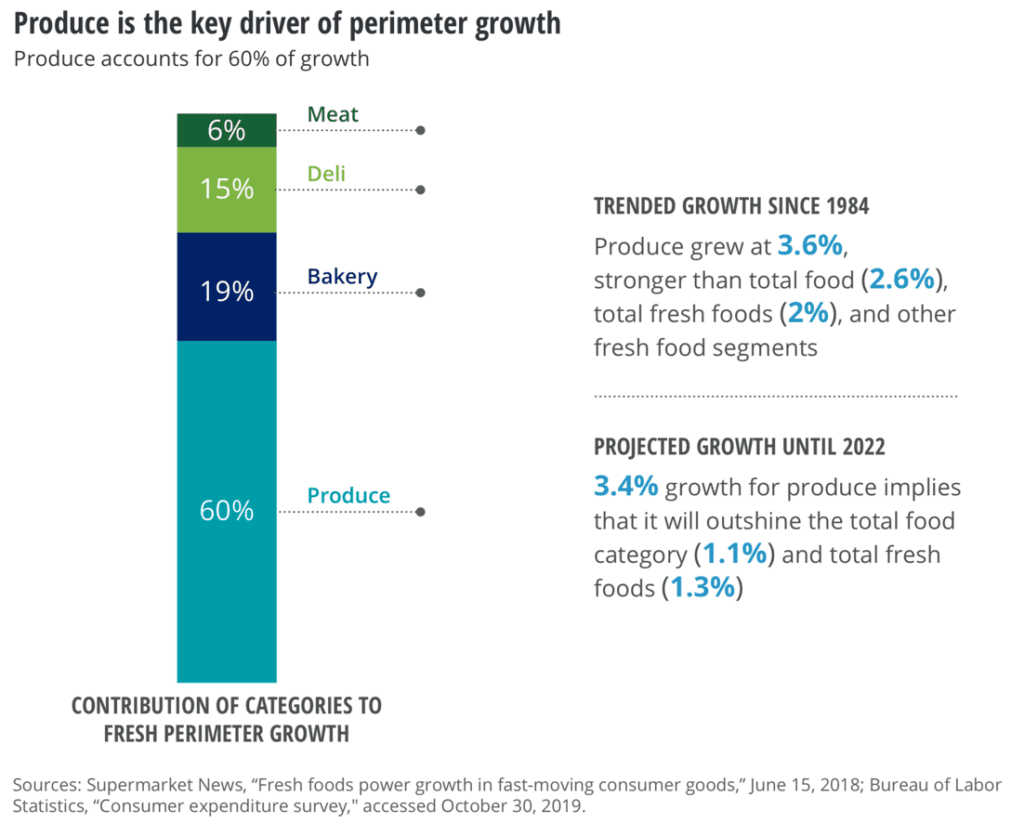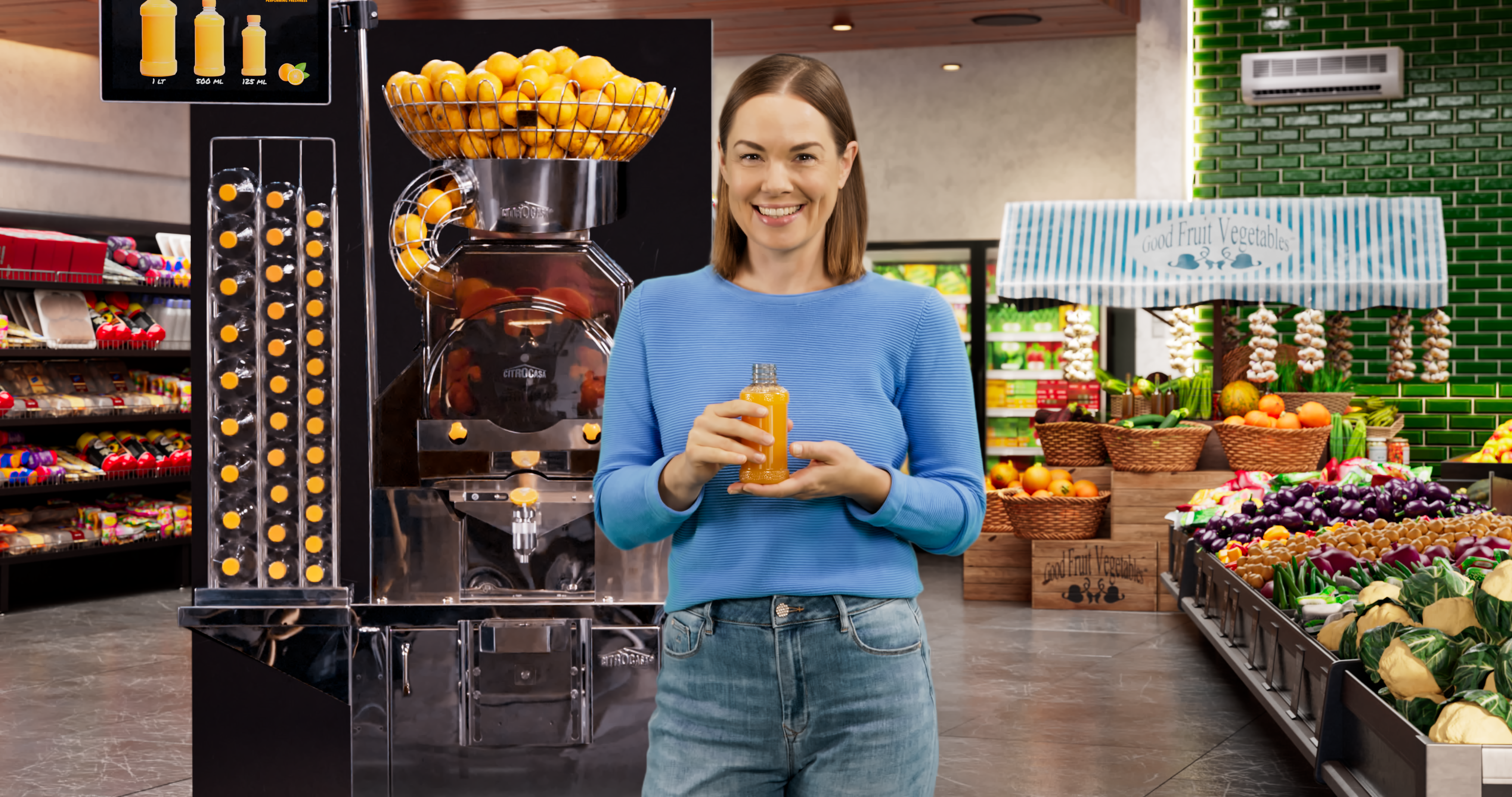5 Ways Fresh Citrus Juicing Can Enhance Customer
Experience and Perimeter Growth
IN-STORE SHOPPERS ARE BACK
According to this article on Statista, shoppers in the US tend to favor supermarkets as their go-to place for everyday food. While the online segment is growing, physical stores continue to dominate edible grocery sales. Online sales are projected to reach 13.5% of the total grocery market in 2023 and grow to about 20% by 2026.
Even though there is some loss to online shopping, those numbers indicate that in-store sales will remain crucial for the industry for years to come.
An article published on Grocery Dive early this year, describes eight trends that will shape the grocery industry in 2023. One of the trends highlighted is the return to in-store shopping. Shoppers are back in person, but it’s crucial for grocery stores to provide memorable, positive experiences to ensure that they keep on returning. Innovation is a key ingredient for keeping brick-and-mortar businesses alive and successful.

THE FRESH DEPARTMENT AS YOUR MAGNET
Shoppers and their expectations are changing. One of the reasons for this is the rise of Gen Z, who are starting to make their own purchasing decisions. As described in the article The future of the fresh perimeter on supermarketperimeter.com, younger shoppers want convenience, they want healthy food, and they want to know what they are consuming and where it’s from: “Convenience. Health and wellbeing. Transparency. They’re all
huge trends in themselves. Put them together, and you have a force to be reckoned with — and a vision for the grocery fresh perimeter that’s very bright indeed.”
The earlier-mentioned Grocery Dive article also stresses the key role of the fresh perimeter and cites Kevin Kelley, principal and co-founder of Shook Kelley, a design firm in the restaurant and grocery industries. Kelley says that right now, many grocery stores have up to 80% of shelf-stable product and only 20% perishables. He believes that we are going to see that paradigm shift completely.
Industry experts see the center-store shrinking and the fresh perimeter growing. That means that the performance of a store’s perimeter becomes even more critical for overall success. The fresh foods located in the perimeter – produce and fresh-cut, baked goods, dairy, meat, seafood, freshly prepared meals – are a major draw for getting people into the store and increasing sales. So, it makes a lot of sense to invest in these departments, even more so, considering the predictions of the shifting paradigm.
The Produce Department, according to Deloitte, drives 60% of perimeter growth. Adding some exciting In-Store Experiences can greatly enhance your perimeter and keep customers coming back for “Fresh” on a regular basis.

UPSCALING YOUR PERIMETER WITH FRESH JUICE
Investing in the fresh perimeter seems to become a prerequisite for staying competitive and ahead of the curve. It’s particularly interesting for smaller grocery stores as a way to stand out against larger competitors.
One fresh product that can set stores apart is juice – not just any juice, but
- juice freshly squeezed on an automatic juicer on premise or, even better,
- juice freshly squeezed in self-service mode on a customer-facing juicer.
Before we talk more about the ways in which a fresh juicing program can help you and your store, let’s talk about what “juice” really means.
NOTHING BUT JUICE
Various companies use “juice” for beverages that are not just juice. They add water, sweeteners, artificial flavors, preservatives, and other non-natural ingredients. We at Citrus America believe that if you mix in other things it’s no longer just juice. It’s what we would call “juice drinks” or “juice beverages”. Many of these bottled beverages are not fresh and not natural.
When we at Citrus America talk about juice, we mean just that: juice. Nothing added or altered.
It’s pretty straightforward: Juice is the liquid present in and extracted from fruit or vegetables. So, orange juice is the liquid extracted from oranges, lime juice is the liquid extracted from limes, pomegranate juice is the liquid extracted from pomegranate, and so on. You only need fruit or vegetables to make juice – and a well-functioning juicer. Nothing else.
DEFINING FRESH AND NATURAL
“Fresh” product is not canned, processed, pasteurized, or otherwise preserved. Fresh products, such as fresh fruit, fresh bakery items, fresh deli items, fresh fish, etc., have a shorter shelf-life because they don’t contain preservatives. They are generally meant to be consumed within a few days. If it’s been processed and packaged for longer shelf life, it’s not fresh.
“Natural” seems to be a bit harder to define. Since there is no firm definition of the word and no regulation regarding its use for juice, it can be challenging to determine what can and should be labelled natural and what not. Generally, though, “natural” is understood to be free of artificial ingredients or added color. It’s either not processed at all or only minimally processed in a way that does not alter the product. It’s the way it was made by nature.
DOES NATURAL MEAN ORGANIC?
Natural and organic are not the same. Organic refers to how the fruits and vegetables are grown. It means that no chemical fertilizers, pesticides, or other artificial agents were used anywhere in their production. Organic is in contrast to non-organic or conventional.
So, a product, like juice, can be natural, even if the fruit used was conventionally grown (vs. not organically grown). For example, the oranges you juice may have been treated with pesticides to keep away destroying insects. When pressed, the juice is still natural. But it’s not organic.
Organically grown and natural may be an ideal combination but organic is not a prerequisite for natural. If you juice your citrus on a Citrocasa juicer, it is always natural. Whether it’s also organic depends on the fruit you use.
“NATURAL” CLAIMS: IS IT REALLY WHAT IT SAYS IT IS?
Over the past few years, there has been an uptick in the number of lawsuits filed over food and drink products labeled “natural”, according to ClassAction.org. Some companies have been using the descriptor “natural” to advertise their products to consumers looking for healthier options. In some cases, the “natural” products contained artificial ingredients, chemical preservatives, or were highly processed.
In the juice industry, quite a few companies have been facing legal action.
- As described by ClassAction.org, “Simply Orange Juice Company is facing legal action claiming that the “100% pure-squeezed” claims on its orange and grapefruit juices, as well as the “all natural” claim on its grapefruit juice, are misleading because the beverages are actually highly processed.”
- The situation is similar for Tropicana’s claim of “100% pure and natural”. As described on the class action site, the plaintiff alleges that Tropicana stores their juice for up to a year before shipping it out to stores. “But before Tropicana ships its juice out, the company adds chemically engineered “flavor packs” to the beverages to reinstate the missing fresh-juice flavor, according to the suit.”
- According to the lawsuit filed against Naked Juice, the juices contain artificial ingredients. Naked Juice Co. was accused of adding synthetic ingredients and ingredients derived from genetically modified crops to its juices.
Understandably, these questionable claims confuse consumers, and they lead to a loss in consumer trust. Regardless of the outcome of these lawsuits and whether they are with or without merit, it represents an erosion in consumer confidence in these brands. This presents grocery retailers an opportunity to provide fresh products and deliver on their promise to provide fresh and healthy options.
Fresh, in-store prepared products are a great way to give consumers the freshest in-store experiences.
Our definition of fresh juice:
- cold-pressed,
- freshly made in-house,
- no additional ingredients (not even water or sugar, unless it’s a lemonade or limeade type of product and ingredients are clearly listed),
- no added preservatives,
- no altering processes and
- as close to the original fruit as one can get.
That is what “natural” means for us at Citrus America – and it always applies to the juices pressed on our juicers: Citrocasa commercial citrus and pomegranate juicers. Of course, products such as lemonade or smoothies may call for other ingredients, such as yogurt, sweeteners, or fruit purees, to be added, but fresh juice still makes up a significant portion of the recipe and the ingredients are clearly labeled.
The 100% natural and pure juices pressed on Citrocasa juicers are superior in taste. Fresh orange juice with low peel oil leaves out the bitter peel substances, which allows the natural sweet flavor and fresh aromas to be enjoyed without adding sweeteners or artificial ingredients. Of course, these 100% pure and natural juices can be used to prepare other beverages, such as lemonade, limeade, or alcoholic and non-alcoholic craft cocktails.

THE VALUE OF A JUICING PROGRAM
So, now that we have gotten the definitions out of the way, let’s have a look at what a fresh juicing program can do for you and your store.
- Enhanced Customer Experience:
Even, or maybe especially, in the fresh department, customers want to be wowed. They come to the perimeter, because they are not just looking for a box, can, or bottle of processed product. They walk through the fresh department with their senses on high alert. A product that is freshly made in store, possibly even in front of their eyes, creates a sensual experience for them.We also believe that customer experience goes beyond what happens in the store. We know that when customers try freshly squeezed orange juice from one of our juicers, they are blown away by the taste.
- Drive Perimeter Growth:
A fresh juicing program will bring customers into your store, to the perimeter, and drive perimeter growth. It can be a reason for people to enter the store. As mentioned at the beginning of this blog, experts predict what could be called a flip between perishable product and shelf-stable product. Where we now have a 20 to 80 ratio of perishable to shelf-stable, we may see reverse numbers in the future.A fresh juicing program, especially one with a customer-facing juicer, would support that and help make your perimeter more engaging and powerful. Fresh juicing programs and in-store squeezed juice products can support growth in produce departments, in take-away/grab-and-go sections, in bakeries, cafés, and different areas of the store.
- Grow Repeat Business:
A fresh juicing program will support repeat business and help increase in-store frequency and consumer loyalty. The experiences described above will draw people back into the store. Some consumers may come in just for the juice but if done right, they are likely to purchase more, filling their grocery carts with other attractive products.One of the consumer priorities mentioned earlier was convenience, being able to grab fresh product on the go. Just imagine fresh juice placed near the bakery, deli, or fresh prepared meals department. Customers who came in for orange juice may also grab some freshly baked croissants or a sandwich – and the other way around. Repeat business will grow out of the ideal combination of fresh items.
- Consumer Trust through Transparency:
Earlier in this blog we talked about questionable claims made by producers. Consumers are becoming increasingly skeptical of natural and healthy claims. It’s increasingly difficult to convince customers that things are the way they say they are.Freshly squeezed is the most transparent way of making and selling juice. The juicer is right there for your customers to see. The product is made in the store, ideally even on-demand. Consumers can see with their own eyes that the product is truly fresh and truly natural. Transparency is crucial for consumer trust. And if consumers trust you and your product, they are more likely to come back.
- Support Brand Development:
A fresh juicing program is also a great way to promote your private label efforts. We support our customers with peripherals and bottles – and with know-how and juicing expertise. A juicing program is a great opportunity to create or bolster your own label and support brand development.
Concerned about return on investment? Yes, a Citrocasa juicer is an investment, and you may be worried to take such a step at a time of increasing costs and inflation. But that is exactly why it makes sense. Our most powerful juicers juice 40 fruit per minute, our smaller juicers 30 fruit per minute. There is no need to peel or slice the citrus. The process is fully automated. Some of our customers have been juicing with the same juicer for 10+ years. With rising labor costs and the challenges of staff turnover, a juicer provides some substantial advantages over using human labor. On top of it, it’s an investment into the future, into an area of your store that is predicted to grow dramatically and drive overall store growth.
The five points described above will rapidly translate into healthy profits. Not sure how? Contact us and we can tell you more about how you can turn a fresh juicing program into a powerful and profitable player in your perimeter.
About Citrus America – Citrus America has been driving innovation and quality in the juicing segment for more than a decade in North America and the Caribbean. We’re the exclusive master distributor for Citrocasa and have driven many innovations and quality improvements in juicing equipment. In addition to equipment solutions, we provide tailored training and support strategies to help our customers earn Healthy Profits.
About Citrocasa – Citrocasa has been the pioneer in producing the most innovative and highest quality food grade stainless steel commercial citrus juicing equipment to the grocery, hotel, and restaurant since 2005 across Europe. The Citrocasa 8000 Series was launched in 2005, with the 8000XB and the 8000SB. The 8000SB-ATS was launched in 2013. The Citrocasa Fantastic Series was launched in 2010 with the Fantastic M/AS. The Fantastic F/SB followed in 2011. Between 2015 and today, Citrocasa has launched the Advance upgrades, The Revolution, The Eco, and has added new options for on-line connectivity continuing its role as being the leader in commercial citrus juicing quality and innovation.







